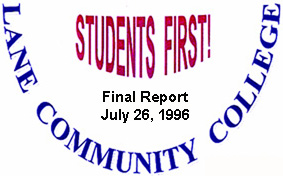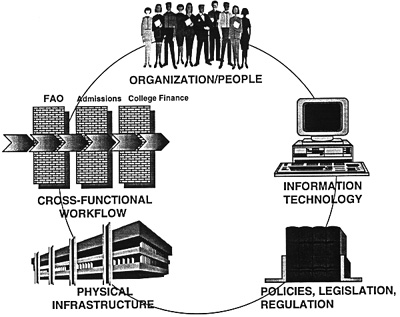| Lane Home Page | Search Lane |
| Website Accessibility |
 CHAPTER FOUR: RECOMMENDATIONS
CHAPTER FOUR: RECOMMENDATIONS
Table of Contents | Main Students First! Page This chapter describes the changes the Students First! Redesign Team recommends to improve services to students at Lane. To develop these recommendations, the Redesign Team conducted careful analysis of the findings developed through the research steps described in Chapter Two. The work of the Redesign Team also was guided by the following overarching principles of redesign. Redesign Principles
In addition to these principles, as the team developed their recommendations, they took into consideration each of the five dimensions redesign. These five dimensions are: organization/people; information technology; policies, legislation and regulations; physical infrastructure; and cross-functional workflow. These dimensions are illustrated in the following graphic.

Format of Recommendations To facilitate understanding of the recommended changes, the Redesign Team developed each recommendation according to a consistent format. The format consists of:
List of Recommendations Below is a list of the twelve recommendations developed by the Redesign Team. The recommendations are organized into six categories, according to the type of services they address. It is important to note that these categories do not correspond with departments or other organizational units at Lane, but rather with a type of service from the perspective of the student. This list of recommendations is not in order of priority: the Redesign Team considers each recommendation to be of equal importance. However, those recommendations addressing service delivery and information dissemination represent overarching changes that will affect all services to students at Lane. This chapter concludes with the detailed recommendations according to the format described above. Service Delivery
Information Dissemination Financial Transactions
Enrollment
Advising, Counseling, and Career Development
Support and Diversity Services
Additional Recommendations In addition to the twelve major recommendations, the Students First! Redesign Team developed a number of recommendations that can be implemented relatively quickly and easily since the recommendation has one or more of the following attributes:
These 'quick wins' are described in Appendix G. Also, in Appendix H is a list of ideas and issues outside the Students First! Redesign Team's project scope that they recommend be addressed by others. A Day in the Life of a Staff Person at the New Lane When these recommendations are implemented, they will create a new and better Lane for students and services to students employees alike. Below is a hypothetical 'day in the life' of an employee who works at the centrally located Students First! Center in 1998. The scenario describes some of the changes that will have taken place as a result of implementing the Students First! recommendations, as well as other advances that Lane may anticipate in coming years. At 7:30 a.m., Resource Representative Anne Doe begins her day by reviewing the priority items in her computerized calendar. She then pulls up her bulletin board on the WAN containing notes from other Lane employees who work outside of her "Flex Time" hours. This flexibility has allowed Lane to offer classes and services from 6 a.m.-11 p.m. for the convenience of more county residents than anyone thought would be practical or cost effective, even as recently as 1996. She reviews the Daily On-Line, taking note of the twelve percent increase in this year's admissions applications and a compendium of student satisfaction survey data showing ninety- six percent of respondents rating the services to students as "very good" or "excellent." From 7:45-10:45 a.m., Anne attends directly to current and prospective students who access the Students First! Center in person or by phone. Because of the training she received in customer service, Anne feels confident that she can deal with even the most disgruntled student. Since a new term is about to begin, many of the students Anne serves are interested in getting assistance with the admissions process. Some visit to learn about the services at Lane Community College and potential courses of study. Others need to resolve errors in their automatically entered application, through which a computer program automatically identifies missing, inaccurate or incomplete information. Records of these contacts with students are automatically attached to their account information for future follow up, as appropriate. Specific corrections are made directly into the computer while a log is made and correspondence initiated to send brochures and other information to those making routine inquiries. Requests for instructor contact are forwarded via the computer bulletin board to the specific instructor or department for a direct response. Anne takes her break while walking to her 11:00 a.m. Implementation Team meeting. This Team is working on refining some of the changed advising processes that were recommended by the Students First! Redesign Team in 1996. Since Anne is cross-trained in enrollment, financial transactions, support services, and other services to students, she is a key member of the Team. From 12:00-12:30 p.m., Anne takes part in a strengthening and conditioning class on campus. Since her back surgery in 1994, she has continued to make this a regular part of her work week and has had little trouble since then. Since her job has changed so much in the last two years, she feels less work-related stress, which she feels has also contributed to addressing her back problem. She stops at the Taco Time for a Veggie Burrito and a soft drink at the cafeteria on her way back to the Students First! Center. Anne arrives back at the Students First! Center at 1:00 p.m. and talks with a dislocated worker who received a GED from Lane in 1976 but now must consider going back to school to gain more marketable skills. Just two years ago, this prospective student would have had to make visits to the Financial Aid Department, the Computing Center, the Counseling Department, and Training and Development to have his needs met. Today Anne is able to address all his needs at the Students First! Center. At 1:15 p.m., Anne gets a call from College Finance asking her to help with a staff shortage in that department. Since the other Students First! resource representatives assure her that they can handle the volume of students that afternoon, Anne agrees to help them out. Having been cross-trained in billing processes, Anne pulls up error audits, identifies errors, and either makes corrections to remove registration holds or downloads letters with appropriate instructions to the College Finance printers. Work-study students fold and mail the letters prior to the afternoon mail pickup. From 3:45-4:30 p.m., Anne handles end of the day chores that include insuring that all notes and information have been handled or passed on to other campus personnel. She leaves bulletin board messages for those working early morning flex hours and posts messages in her "Public File" regarding students who may call her back after she leaves for the day. As time permits, she also works on computer-based, interactive and self-paced learning modules dealing with interdepartmental cross-training or self-improvement programs such as conflict resolution. Detailed Descriptions of Each Recommendation Details regarding each of these recommendations, in the format described above, follow. While the recommendations were developed by the entire Students First! Redesign Team, the following recommendations were written by one or more members of the Team who worked intensively in their respective recommendation area. Service Delivery
Information Dissemination
Financial Transactions
Enrollment
Advising, Counseling, and Career Development
Support and Diversity Services
Read the Change Proposals and Action Plan section of this report. |
>> Return to Lane's Home Page >> Return to Process Redesign Project Main Page >> Return to top of page Lane Community College - Process Redesign Project 4000 East 30th Avenue, Eugene, OR 97405 Please direct comments about this site to webmaster@lanecc.edu Revised 12/2/96 (llb) © 1996-present Lane Community College |
